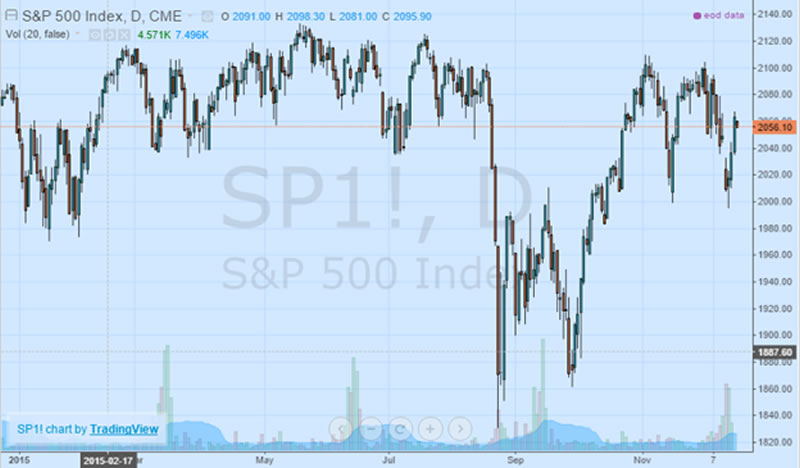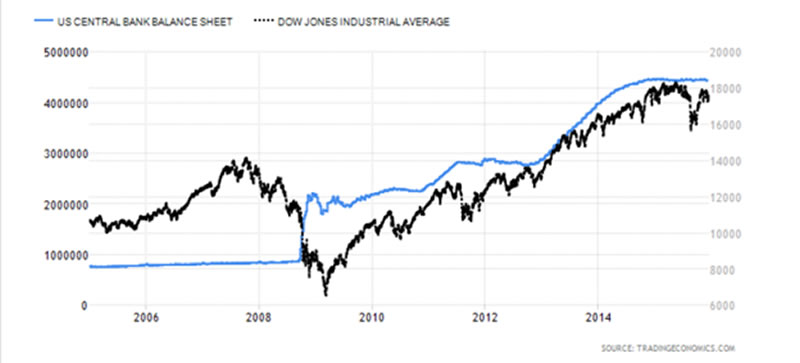Stock Market S&P 500 Rally Might Prove Short-Lived
Stock-Markets / Stock Markets 2015 Dec 17, 2015 - 02:10 PM GMTBy: AnyOption

 To much fanfare, the Federal Open Market Committee made the decision to raise interest rates by 25 basis points for the first time since 2006 in a unanimous decision approved by all voting members. This marks the beginning of a tightening cycle that forecasts another 4 rate increases over 2016, putting rates near 1.50% by the end of 2016 should the United States economy avoid a recession. When looking at corporations and the main sources of growth over the past few years, interest rate normalization is largely a negative indication for equity valuations as it diminishes the viability of cheap borrowing to finance buybacks. Although the announcement of a hike was forecast to dent equity benchmarks, especially the S&P 500, the cash session saw a 1.45% rally in the index despite the headwinds approaching.
To much fanfare, the Federal Open Market Committee made the decision to raise interest rates by 25 basis points for the first time since 2006 in a unanimous decision approved by all voting members. This marks the beginning of a tightening cycle that forecasts another 4 rate increases over 2016, putting rates near 1.50% by the end of 2016 should the United States economy avoid a recession. When looking at corporations and the main sources of growth over the past few years, interest rate normalization is largely a negative indication for equity valuations as it diminishes the viability of cheap borrowing to finance buybacks. Although the announcement of a hike was forecast to dent equity benchmarks, especially the S&P 500, the cash session saw a 1.45% rally in the index despite the headwinds approaching.
End of an Era
Balance sheet expansion via quantitative easing and money printing was largely possible for stocks, helping to reflate the bubble in the aftermath of the financial crisis of 2008-2009. With limited opportunity for investor capital to chase after, traders hunting for yield were channeled towards riskier returns, namely in stocks because of the ease of entry and exit. The last five years since the crisis have seen extraordinary returns with the S&P 500 nearly tripling over the time period.
However, much of these gains have not necessarily been the result of revenue growth, but mostly a factor of a combination of internal cutbacks and stock buyback programs. By slashing costs, cutting staff, and improving efficiency, these very corporations have been able to maintain the bottom line despite the top line stagnating. Nevertheless, at a certain point, there is nothing left to cut and it becomes the equivalent of squeezing blood from a stone.
Buybacks Defining Momentum
The other gimmick that was popular to go ahead and raise equity valuations was the buyback scheme that was very prevalent across the S&P 500 over the last few years, boosting stock prices and payouts for C-suite executives. At the zero bound, it was much easier to finance these buybacks then in an environment of rising interest rates. According to recent statistics, share repurchases are forecast to reach $1 trillion by the end of the year, helping to boost asset prices as companies push earnings growth in lieu of expanding in a sluggish market environment.

In many ways, this is the only reason these companies have managed to show positive earnings growth especially in a time of a corporate revenue recession according to the latest available figures. Revenues expansion has slowed to a crawl or even shrunk depending on the company, with the S&P 500 nearly flat for the year, only up 0.69% year-to-date.
Balance Sheet Contraction Leads to Valuation Shrinkage
Despite the Federal Reserve forecasts expecting stronger growth in 2016 based on the revision higher in GDP projections from 2.30 to 2.40%, the real question is how the balance sheet will respond to the changes in policy. As has been noted, over the past few years, as the Central Bank balance sheet has expanded, stock valuations have risen in conjunction. Although not perfect, there is a strong correlation between the rise of stock indices such as the Dow Jones Industrial Average and S&P 500 versus the Federal Reserve balance sheet size.

It is evident based on the fact that the S&P 500 has barely budged for the year, trending continuously sideways in between positive and negative returns since the beginning of the year. Although analysts are expected another year of 10%+ growth in valuation of the S&P 500 for 2016, Federal Reserve efforts to mop up excess liquidity combined with reducing the size of the balance sheet could consequently reduce stock valuations and weigh on benchmarks. With a current price-to-earnings ratio of 21.84 and the mean over the last 100+ years closer to 15.57, the S&P 500 could see a deeper pullback over the coming months, erasing approximately 25% of the benchmark’s value as conditions normalize.
The strength of the dollar is also a contentious issue for stocks because for American multinationals it weighs on earnings and for companies it general, it makes shares more expensive on a relative basis compared to international peers and competitors. The US dollar has notably strained the export economy and quantitative tightening is likely to translate to further gains in the coming months especially if the latest Federal Reserve decision proves to be the first rate hike of many to come. With the dollar only forecast to ascend further, the currency pressure underperformance from key equity benchmarks.
Conclusion
The S&P 500 might have shown a modest relief rally during the cash equity session yesterday, however, despite a potential Santa Clause rally, the benchmark does look set for a reversal in the coming months as the harsh realities of higher rates catch up with corporate America. Although set to benefit the real economy, the financial economy will not profit to the same degree from these changes. It will end the era of cheap financing for buybacks and also weigh on revenues as international markets become harder to chase with a stronger dollar. The balance sheet reduction will also see an impact as the Federal Reserve works to mop up excess liquidity sloshing around the financial system. With the current valuation of the S&P 500 benchmark very stretched, a move back lower and sharper correction is not unforeseeable with the first target on the downside 1950 before paving the way for deeper losses.
Anyoption™ is the world's leading binary options trading platform. Founded in 2008, anyoption was the first financial trading platform that made it possible for anyone to invest and profit from the global stock market through trading binary options.
Our goal here at Market Oracle is to provide readers with valued insights and opinions on market events and the stories that surround them.
Website anyoption.com
© 2015 Copyright Anyoption - All Rights Reserved
Disclaimer: The above is a matter of opinion provided for general information purposes only and is not intended as investment advice. Information and analysis above are derived from sources and utilising methods believed to be reliable, but we cannot accept responsibility for any losses you may incur as a result of this analysis. Individuals should consult with their personal financial advisors.
© 2005-2022 http://www.MarketOracle.co.uk - The Market Oracle is a FREE Daily Financial Markets Analysis & Forecasting online publication.


